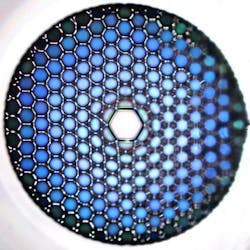For applications such as spectroscopic investigations of ions or atoms, laser light in the ultraviolet (UV) is often used. While fiber-optic delivery of light has many advantages, UV light can quickly damage conventional optical fibers. Researchers from the Max Planck Institute for the Science of Light (MPL; Erlangen, Germany) and the QUEST Institute, based at the Physikalisch-Technische Bundesanstalt (PTB; Braunschweig, Germany), have created and tested UV microstructured fibers with hollow cores; these fibers maintain single-mode guiding of the UV light.1
The researchers found that this type of optical fiber is able to guide UV laser light without being damaged and with acceptable loss. In addition to precision spectroscopy on atoms or ions and their use in optical atomic clocks or quantum computers, these UV-transmitting fibers can potentially be used in fluorescence microscopy for biology, the investigation of process plasmas, combustion studies on soot, and the spectroscopy of greenhouse gases.
Kagome structure
It was determined that a certain type of optical fiber is particularly well-suited for UV light: a microstructured photonic crystal fiber (PCF) with a so-called "Kagome" structure consisting of triangles and of hexagons in a regular arrangement, and with a hollow core of 20 µm diameter. This core ensures single-mode operation. Metrological experts from the QUEST Institute at PTB did indeed show that, using UV light with a 280 nm wavelength, single-mode transmission was possible -- and that even after more than 100 hours of operation at a power of 15 mW, no UV-induced damage could be detected.
The optical fibers have passed a first application test: the researchers at the QUEST Institute used them successfully for spectroscopic investigations on trapped ions. Stabilized by the new fiber, the UV laser beam allows an improved interrogation of the ions' internal state. In addition to the users of such spectroscopic methods (for example in astronomy, chemistry, or fundamental research in physics), the fiber could be useful to researchers who are developing quantum computers.
REFERENCE:
1. F. Gebert et al., Optics Express (2014); http://dx.doi.org/10.1364/OE.22.015388

